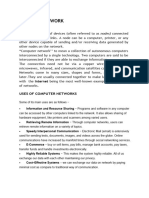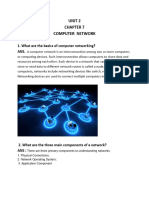Digital -Era
Chapter-1 Networking Concepts
Contents of the chapter:
What is a network?
Need of networking
Elementary terminology of network
Types of networks
Networking architecture
Network topology
1.1 Introduction to Network
A network is an interconnected collection of independent computers. Two computers are said to
be interconnected if they are capable of exchanging information. Therefore, a network allows
computer users to share computer equipment and programs, messages and information available
at one site. For example, if one of the computers in a network has a printer attached to it, then
all the computers in that network can access the printer and use it to print the documents as
shown in the following figure.
Figure: Computer Network
Each computer in a network is called as a Node. All the computers in a network can be linked
through cables, telephone lines, radio waves or infrared beam.
1.2 Need of Networking-
Networking is necessary for the following reasons:
To share files/folders: Networks provide a very effective method to share the files with
different users. For example, in an organization one file is to be shared by different
departments, we place this file on network system. Now, all the departments can use this
file.
To share computer peripheral: Some computer devices are very expensive. For example,
laser printer and large hard disks are quite costly. Network enables us to share these costly
devices.
9|Page
TECH-SERIES By ECMS
� Digital -Era
To enable different computers to communicate with each other: Networks allow
different computers to communicate with each other. For example, a computer with
operating system Windows can communicate with a computer having different operating
system like Linux.
To share information across network: We can send the messages through e-mail or any
other instant messaging app in fraction of seconds.
To reduce the hardware cost: If we share the hardware in a network, purchasing cost can
be reduced. For example, instead of installing the printer on each computer in a network,
we can install one printer on a network and share it among all the computers in a network.
This will help us in avoiding the cost of purchasing many printers.
1.3 Network Terminology
In networking, we come across various networking terms like:
Nodes (Workstations). The different terminals which are attached to the network and
share the resources of the network are called nodes. When we attach a computer to the
network, it becomes the workstation of a network.
Server. A server is a powerful computer or system that provides resources, data, services,
or programs to other computers over a network. Servers act as central repositories within
a network environment.
Network Interface Unit (NIU). The interpreter, which helps in communication between
the server and different nodes, is called Network Interface Unit. The Network Interface
Unit is a device that is attached to server and all the workstations to maintain the
connection between them. Each Network Interface Unit has a unique node address.
1.4 Types of Network
Depending on the geographical area covered by a network, there are various types of
computer networks, which are mentioned below:
PAN (Personal Area Network)
LAN (Local Area Network)
MAN (Metropolitan Area Network)
WAN (Wide Area Network)
1.4.1 Personal Area Network (PAN)
Personal Area Network is a computer network that is
Inquest: Connecting your car
mainly created for an individual person. It is used for
bluetooth and smartwatch with
communication among devices such as Laptops, mobile
your smartphone is an example
phones, PDAs or smartphones.
of which type of network.
They can be either wired or wireless. PAN generally Name and explain it.
involves a range of less than 10 meters (about 30 feet).
You can use these networks to transfer files including e-mails, calendar appointments, digital
photos, music etc. A real-life example of PAN is the connection between a Bluetooth earpiece
and a smartphone.
10 | P a g e
TECH-SERIES By ECMS
� Digital -Era
1.4.2 Local Area Network (LAN)
Local Area Networks, generally called as LANs, are privately owned networks within a single
building or campus, of up to a few kilometers in size. They are widely used in an office
building, a school or a home. A LAN is useful for sharing resources like files, printers, games
or other applications. A LAN in turn often connects to other LANs and to the Internet or other
WAN.
LAN characteristic features are:
Total diameter is not more than 1-10 km.
It provides E-Mail and other communication services in office systems.
It provides user with access to several resources viz. computer, terminals, printers, file
server, etc.
1.4.3 Metropolitan Area Network (MAN)
Metropolitan Area Network or MAN is big in size as compared to LAN and normally uses
similar technology. It might cover a group of nearby corporate offices or a city and might be
either private or public. It is smaller than a WAN. A MAN is typically owned and operated
by a single entity such as a government body or large corporation.
1.4.4 Wide Area Network (WAN)
A Wide Area Network, or WAN, spans a large geographical area, often a country or continent.
It is a network that provides communication services to a geographic area larger than served
by a LAN or MAN. WAN is usually connected via radio or telephone links rather than
dedicated lines. The first WAN to be designed and developed was private network ARPANET
(Advanced Research Project Agency Network) in USA. A WAN is also known as a Long
Haul Network. The Internet is the largest WAN, across the Earth.
WAN 's are:
It covers a larger area with lesser cost.
With the help of WAN, data can be entered or retrieved from the far-flung remote areas
with lesser cost with the help of a satellite.
1.5 Networking Architecture
Network architecture refers to the design of computer network. It is the way in which
different network devices (i.e., the clients such as PCs, desktops, laptops, mobiles etc.) are
arranged in order to fulfil the needs of the end user/customer.
Network architecture is classified into following categories:
Figure: Types of Network Architecture
11 | P a g e
TECH-SERIES By ECMS
� Digital -Era
1.5.1 Peer-to-Peer Network:
Peer-to-Peer is a network where a few computers having
equal capabilities are connected together to use the resources
available on the network. It is a communication model in
which each computing device on the network can function as
either a server or a client.
1.5.2 Client-Server Network
In this network, several computers called clients or workstations are connected to the main
computer called the server.
Client – The client can be any computer that requests something from the server. For
example – For visiting any website, we request the webpage from its server.
Server – On the other hand, the Server is the computer that is designed to serve the requests to
the client. For example, the client asks for the webpage, then the server responds with the
webpage to the client.
Client-Server Architecture
1.6 Network Topologies
The pattern of interconnection of nodes in a network is called the topology. In other words, a
computer network topology is the physical communication scheme used by connected
devices.
1.6.1 Bus Topology
Info-bit: Bus networks
Bus topology is a popular topology for data networks. It is typically work well for
a series of nodes which are all connected to a backbone. smaller networks and use
This consists of a single length of the transmission medium
onto which the various nodes are attached. Bus network Ethernet cables (LAN cable)
works with very limited devices. for networking.
Performance issues are likely to occur in the bus topology if more than 12-15 computers are
added in a Bus Network.
12 | P a g e
TECH-SERIES By ECMS
� Digital -Era
Advantages of Bus Topology:
It is the easiest network topology for connecting peripherals or computers in a linear
manner. It works well when there is a small network.
The length of cable required is less than a star topology.
Easy to expand by joining the two cables together.
Disadvantages of Bus Topology: Inquest:
Bus topology is not suitable for large networks.
Why do we prefer bus topology
Identification of problems becomes difficult if the whole
for large networks?
network goes down.
Terminators are required at both ends of the main cable.
If the main cable is damaged, the whole network fails or splits into two.
1.6.2 Ring Topology
In this topology, each node is connected to only two neighbouring nodes.
Data is accepted from one of the neighbouring nodes and is transmitted onwards to another.
All the communication messages travel in the same direction whether clockwise or anti-
Info-bit:
Ring Topology is circular in
shape and every node will have
one node on either side of it. This
topology is rare to come across
because of its limitations.
clockwise. After passing through each node, it returns to the sending node, which removes it.
Any damage of the cable of any node or device can result in the breakdown of the whole
network.
Advantages of Ring topology:
In this data flows in one direction which reduces the chance of packet collisions.
Ring topology is also cost-effective as it requires less cabling compared to other topologies
such as bus or star.
Due to the presence of token passing, the performance of ring topology becomes better
than bus topology under heavy traffic.
13 | P a g e
TECH-SERIES By ECMS
� Digital -Era
Disadvantages of Ring topology:
Info-bit:
Due to the uni-directional Ring, a data packet
(token) must have to pass through all the nodes. Star Topology is based on a central
If one workstation shuts down, it affects whole node which acts as a hub. It is
network or if a node goes down entire network common in-home networks where
goes down. all the computers connect to the
Addition and removal of any node during a single central computer using it as
network is difficult and may cause issue in a hub.
network activity.
1.6.3 Star Topology
This topology consists of a central node to which all the other nodes are connected by a single
path. Star topologies can be implemented in homes, offices or even in a building. All the
computers in the star topologies are connected to a central device like hub, switch or a router.
As compared to the bus topology, a star topology requires more devices and cables.
Star topology
Advantages of Star Topology:
It is very reliable – if one cable or device fails then all the others will still work.
It is high-performing as no data collisions can occur.
Easy fault detection because the link is often easily identified.
No disruptions to the network when connecting or removing devices.
Disadvantages of Star Topology
If the connecting network device (network switch) fails, nodes attached are disabled and
can’t participate in network communication.
More expensive than bus topology due to the value of the connecting devices (network
switches)
If hub goes down everything goes down, none of the devices can work without hub.
1.6.4 Tree Topology
The tree topology is a modified form of bus topology. It is comprised of the multiple star
topologies on a bus. It integrates multiple star topologies together onto a bus. Only the hub
devices can connect directly with the tree bus and each Hub functions as a root of a tree of the
network devices. The best example is IBM’s personal computer.
The main difference between this network and the bus is the presence of a “root” of the tree.
14 | P a g e
TECH-SERIES By ECMS
� Digital -Era
When a node transmits, the root receives the signal and rebroadcasts it through the entire
network.
Advantages of Tree Topology:
Info-bit:
As the leaf nodes can add one or more nodes in the
hierarchical chain, this topology provides high Tree topology is a type of network
scalability. topology that resembles a tree. In
The other nodes in a network are not affected if a tree topology, there is one central
one of their nodes gets damaged or does not work. node (the “trunk”), and each node
Tree topology provides easy maintenance and is connected to the central node
easy fault identification. through a single path. Nodes can
Tree Topology is highly secure and reliable. be thought of as branches coming
off of the trunk.
Disadvantages of Tree Topology:
This network is very difficult to configure as compared to the other network topologies.
If the computer on the first level is erroneous, the next-level computer will also go under
problems.
Requires a large number of cables compared to star and ring topology.
1.6.5 Mesh Topology
Mesh Topology is a group of nodes which are all connected to each other and many types of
the connections are possible in a mesh topology. Every single node is connected to the other
nodes in a mesh topology and the chances of connection break down are very minimal in a
mesh topology. It is mostly used on WAN.
15 | P a g e
TECH-SERIES By ECMS
� Digital -Era
Summary
A network is an interconnected collection of autonomous computers.
PAN, LAN, MAN, WAN are the various types of computer networks.
The pattern of interconnection of nodes in a network is called the Network Topology.
The different terminals which are attached to the network and share the resources of the
network are called nodes.
The client can be any computer that requests something from the Server.
Node providing various services to the client is known as the Server.
EXERCISE
A. Fill in the blanks:
1. A _________________ is an interconnected collection of autonomous computers.
2. The different terminals which are attached to the network and share the resources of the
network are called________________.
3. The pattern of interconnection of nodes in a network is called the_____________.
4. ____________________refers to the way in which different network devices are
arranged.
5. ____________, ____________, __________and __________ are the different types of
networks.
6. In a ___________ topology, there is one central node (the “trunk”), and each node is
connected to the central node through a single path.
7. In ______________topology each node is connected to two and only two neighbouring
nodes.
8. The _____________can be any computer that requests something from the server.
B. Application Based Questions:
1. Mr. Rohan has set up his office with 10 computers. He wants to connect computers and
peripheral devices within his office building with wires. Which type of network should
he use?
2. Ms. Ankita is browsing on Internet and requesting to open a webpage on the Internet. She
is acting as which type (Client or Server) on the Client-Server Network Architecture?
3. Mr. Aakash wants to set up a topology and wants to set up the nodes in a linear fashion
as the length of the cable is less. Name the topology which he will use.
C. Define the following terms:
1. Client
2. Server
16 | P a g e
TECH-SERIES By ECMS
� Digital -Era
3. Node
4. Network Interface Unit
5. Personal Area Network
D. Answer the following questions:
1. What is a network? Explain by giving suitable example.
2. Differentiate between LAN and WAN.
3. Differentiate between Peer-to-Peer network and Client Server network.
4. What is network topology? Explain.
5. Write any two advantages and disadvantages of Star Topology.
6. List any three points of need of Networking.
*******
17 | P a g e
TECH-SERIES By ECMS




















































































